|
December 1948 Popular Science
 [Table of Contents] [Table of Contents]
Wax nostalgic about and learn from the history of early
electronics. See articles from
Popular
Science, published 1872-2021. All copyrights hereby acknowledged.
|
Prior to the detonation
of atomic bombs in order to finally bring an end to World War II, the general
public didn't know much about nuclear radiation. Many had of course had x-ray images made
of teeth and/or bones during medical examinations, but the potential dangers of
exposure to large dosages were not considered. Except for unintended exposure in
laboratories, even technical personnel were generally unconcerned about radiation.
Largely justified based on the utter instantaneous destruction and long-term lingering
effects of the bombs, people were - and still are - dubious and fearful of large
nuclear-based installations such as electric power generation plants, research institutions,
and waste storage facilities. Nuclear industry proponents put a lot of effort into
assuaging the fears through promises of safety measures taken to mitigate the likelihood
of catastrophic accidents. This 1948 Popular Science magazine article was
one of the first attempts to address large audiences. Things were sailing along
fairly well until the notorious
Three-Mile Island
(Pennsylvania, U.S.) incident in 1979,
Chernobyl (Ukraine,
Russia) in 1986, and then recently
Fukushima
(Japan) in 2011. It is time, IMHO, to apply the vast knowledge gained in safe nuclear
operation toward building compact nuclear power plants that provide decades of efficient,
all-weather operation, rather than destroying millions of acres of land with photovoltaic
arrays and wind farms. The building and maintenance of the "renewable" sources is
anything but green when all stages, from conception to death, are considered.
Danger ... Radiation
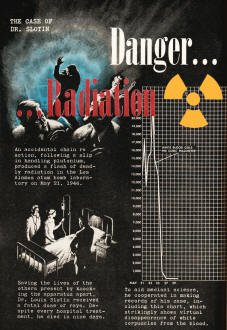
The Case of Dr. Slotin
An accidental chain reaction, following a slip in handling plutonium,
produced a flash of deadly radiation in the Los Alamos atom bomb laboratory on May
21, 1946.
Saving the lives of the others present by knocking the apparatus
apart, Dr. Louis Slotin received a fatal dose of rays. Despite every hospital treatment,
he died in nine days.
To aid medical science, he cooperated in making records of his
case, including this chart, which strikingly shows virtual disappearance of white
corpuscles from the blood.
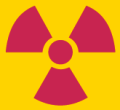 New
sources of rays and applications for them - in medicine, industry, and research
- make living safely with radioactivity our latest problem. New
sources of rays and applications for them - in medicine, industry, and research
- make living safely with radioactivity our latest problem.
By Alden P. Armagnac
When you see a sign bearing a magenta pinwheel on a yellow background and the
words "Danger - Radiation," don't snoop!
Now being used in leading atomic-research centers, and shown above, this newly
adopted warning symbol marks the entrances to "hot" laboratories and identifies
containers that might be radioactive. It bespeaks a new hazard of this Atomic Age
- peril from invisible rays.
Radium and X-ray tubes, about the only known sources of dangerous radiation a
generation ago, merely begin today's list. Now we have fissionable materials such
as plutonium and uranium-235, the therapeutic and "tracer" chemicals known as radioisotopes,
and high-voltage cyclotrons, betatrons, and other ray machines of fantastic power.
Whether you are a chemist, a metallurgist, a mechanic, or a patient in need of
an "atomic cocktail," radioactive substances are daily becoming more likely to playa
part in your profession or well-being. Radioisotopes already are being used in more
than 300 hospitals and laboratories, and applications to industrial problems are
multiplying. The biggest "tracer" experiment to date was made in a steel mill.
The University of Illinois College of Medicine plans to treat cancer patients
with a betatron producing 20-million-volt X-rays. A medical betatron of more than
double this power has just been completed by the General Electric Company. Multimillion-volt
betatrons and semiportable Van de Graaff generators, yielding X rays far more powerful
than conventional tubes, also have been put to work in industry. They permit X-raying
pieces of steel up to 10 inches thick for flaws.
More and more such work will be done, the experts predict, by machines producing
radiation comparable to that from pounds of radium!
So, like it or not, radioactivity is something we must learn to live with. But
no more than a fogbound airman, flying "blind" by instruments, can we depend for
our safety on our ordinary senses.
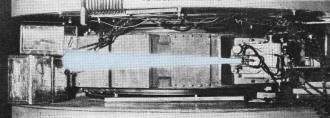
Bright-blue beam of cyclotron, one of rare visible
forms of deadly radiation, consists of speeding deuterons or heavy-hydrogen nuclei
and can kill any living cell it touches.
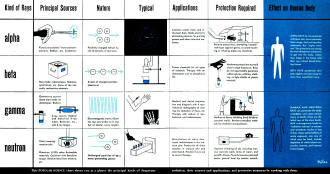
This Popular Science chart shows you at a glance the principal
kinds of dangerous radiation, their sources and applications, and protective measures
for working with them.
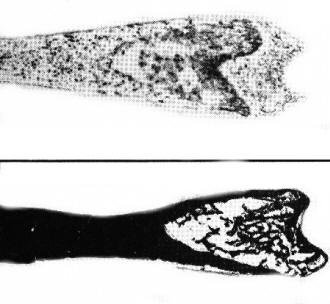
Blackened areas in these two "radioautographs"
of rats' bones register alpha rays from plutonium (bottom) and americium, another
man-made "transuranium" element (top), injected into laboratory animals. Tests showed
hazard of rays' damage to blood-forming marrow.
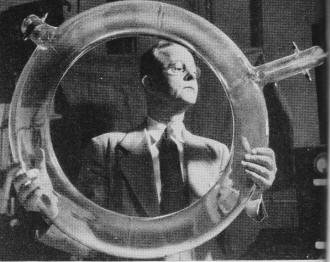
Heart of the 50,000,000-volt GE medical betatron
is this doughnut-shaped tube, modern high-power successor to bulbous X-ray tubes
of conventional design. When electrons speeding around the circular course hit a
target, they produce X rays of extreme penetration.
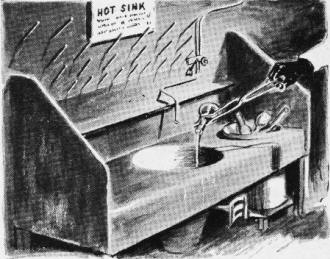
Getting rid of old razor blades is simple compared
to disposing of used radioactive materials. Pouring them down ordinary sink may
form plating of radioactive metal in pipe and endanger an unsuspecting plumber.
Approved sink connects with receptacle for disposal.
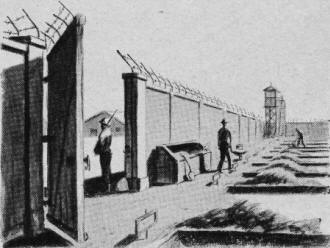
Large-scale plants, like Oak Ridge establishment,
satisfactorily dispose of short-lived radioactive waste by burying it in trenches
on special grounds with guards and locked gate. But this is no answer to problem
of getting rid of materials whose radioactivity lasts many years.
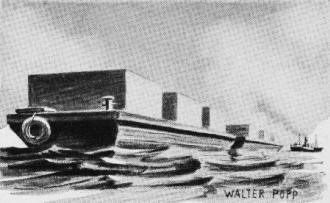
Proposed scheme for future big-scale operations
is to use unwanted radioactive liquids as part of water in making huge concrete
blocks that would be sunk in mid-ocean. Precedent is postwar disposal of unused
poison gas by scuttling shipfuls of shells and bombs at sea.
Only occasionally is radiation danger visible-like the weird bright-blue beam
of a cyclotron, a cold "fire" as perilous to flick a finger through as the flame
of a blowtorch. Geiger counters, clicking like telegraph sounders, and similar instruments
must warn of invisible alpha, beta, and gamma rays - and of a new and equally invisible
kind, neutron rays from atomic fission.
All these rays have very similar effects on human tissue, and the marked difference
in the injury they can do you results chiefly from the difference in the extent
to which they can penetrate the human body. Most dangerous, therefore, are gamma
rays; very penetrating X rays, of similar nature; and neutron rays, the most penetrating
and damaging of all. To these the body is almost as transparent as window glass
is to light.
The strange thing about dangerous or even fatal overexposure to these rays is
that at first a victim feels no ill effects whatever. First symptom, following in
a few hours, is the brief attack of nausea and vomiting familiar to X-ray therapists
as "radiation sickness." After some days, a victim's hair may begin falling out.
Alarming as this may be to him, it is only a surface effect of the rays and not
necessarily an ominous sign in itself. His hair will grow back again if he recovers.
More serious are deep-seated injuries to blood-forming centers like the bone marrow,
with resulting depletion of white corpuscles, red corpuscles, and blood-clotting
elements. Death through infection, anemia, or internal hemorrhages may follow.
To prevent this, a whole new science of precautionary measures has been developed.
It is enriching our language with such terms as the "hot cell," the "dry box," and
the "Cutie Pie."
Walls of concrete up to 10 feet thick around uranium piles and the largest cyclotrons
and betatrons give these remote-controlled installations the appearance of military
fortifications. Sunken sites, below ground level, for the most powerful ones heighten
the impression. Surrounding earth helps absorb any stray rays before they endanger
the neighborhood. Lead bricks also make an effective barrier against their gamma
rays, and tanks of water or paraffin blocks against their neutrons.
"Hot cells," cubicles of concrete two feet or so thick, serve for operations
with "hot" or highly radioactive chemicals emitting up to 100 "curies" of radiation
- the equivalent of nearly a quarter-pound of radium. A typical Oak Ridge hot cell
for purifying mass-produced radioisotopes encloses a space six feet long, four feet
wide, and eight feet high. Using a periscope and twirling the handles of remote
controls, an operator standing outside manipulates a whole train of chemical apparatus
within. Safety experts check exterior radiation with a portable pistol-shaped meter
nicknamed the "Cutie Pie" for its diminutive size.
For the average user of radioisotopes, the small quantity employed requires much
less elaborate safeguards. Moreover, many useful "tracers" emit only beta rays.
These are stopped by light shields of plastic and are largely absorbed by rubber
gloves and by ordinary clothing. An experimenter who handles these chemicals with
tongs or by strings attached to bottles is well protected.
Plutonium, the atom-bomb material, must be handled as if by surgeons dealing
with violently infectious germs. Externally, its alpha rays cannot penetrate unbroken
skin and are harmless. But if plutonium once gets into the body - by mouth, by breathing
its dust, or through a cut in the skin - it lodges permanently in the bones, and
its rays work havoc with blood-forming tissues. Hence workers wear not only gloves
but also special breathing masks whenever there is any chance of inhaling the slightest
traces. If possible, plutonium is kept in solution or moist. Otherwise, experiments
with it must be performed in a "dry box," an airtight windowed cabinet. Workers
insert their hands through gloves sealed in access openings. Departing workers'
hands are scrubbed until a telltale ray detector gives them a clean bill of health.
In ordinary chemistry, mixing certain different chemicals will cause an explosion.
But merely gathering enough of the same fissionable material, like plutonium, in
one place will set off a chain reaction - such as occurs slowly in the atomic pile,
or explosively in the atom bomb - and release the lethal gamma and neutron rays.
This happened on May 21, 1946, at the Los Alamos, N. M., atom-bomb laboratory.
With seven others, Dr. Louis Slotin was handling plutonium. Something slipped. The
mishap brought together a quantity of plutonium exceeding the danger limit.
There was a strange sort of "explosion" in miniature, without noise or blast
- just a blue glow, a flash of heat that could be felt on the skin, and a flood
of deadly invisible rays. Perfectly aware of the consequences, Dr. Slotin stood
his ground, knocked the apparatus apart before the others could receive a fatal
dose of radiation - and, himself, was exposed to thousands of times the amount a
person can absorb without ill effect. Despite every known hospital treatment, he
died nine days later, after cooperating in providing detailed records of his case
for medical science.
That such an accident is a rare exception is a tribute to the skill of experts
in the newly developed science of "health physics." So effective are the precautions
they have devised that not one person has been injured by radiation, to date, in
the great plutonium-making plant at Hanford, Wash. The uranium-235 and radioisotope
plant at Oak Ridge, Tenn., has an equally impressive safety record.
Death rays that can kill a person a mile away are no longer fantasy, but fact,
since Hiroshima and Nagasaki. About 26,000 Japanese atom-bomb casualties, or one-seventh
of the total, resulted solely from only one second's exposure to gamma and neutron
rays loosed at the instant of the bombs' explosions. Obviously there is no minimizing
what an atom bomb could do to one of our own cities despite every possible countermeasure.
Heavy as the casualties would inevitably be, however, modern knowledge of the
effects of these rays shows' how many lives can be saved.
Wholesale blood transfusions, for victims of ray damage to their own blood-forming
organs, would tide over those with a fighting chance of recovery. To ward off internal
hemorrhages, survivors might receive injections of a dye called toluidine blue,
which, scientists have recently discovered, restores the ray-impaired ability of
the blood to clot. Other useful drugs may include one called phenyldrazine, found
to be an antidote for ray-induced anemia.
First to enter an atom-bombed area, the U. S. Army Medical Corps foresees, would
be a task force of atomic scientists and health physicists armed with Geiger counters.
This team would supervise rescue work and direct evacuation of areas rendered uninhabitable
by ray contamination - possibly for years or decades. Some of its members would
have to check on possible contamination of food, drinking water, and even the clothing
of escaping refugees, which might be sufficiently radioactive to be a menace to
others. Thus, use of the atom bomb could create the greatest public health problem
of all time. As long as the possibility of atomic war remains, and as the atom advances
in industry, the need for knowledge and training in radiological safety will be
urgent.
Posted May 10, 2024
|










 New
sources of rays and applications for them - in medicine, industry, and research
- make living safely with radioactivity our latest problem.
New
sources of rays and applications for them - in medicine, industry, and research
- make living safely with radioactivity our latest problem. 






